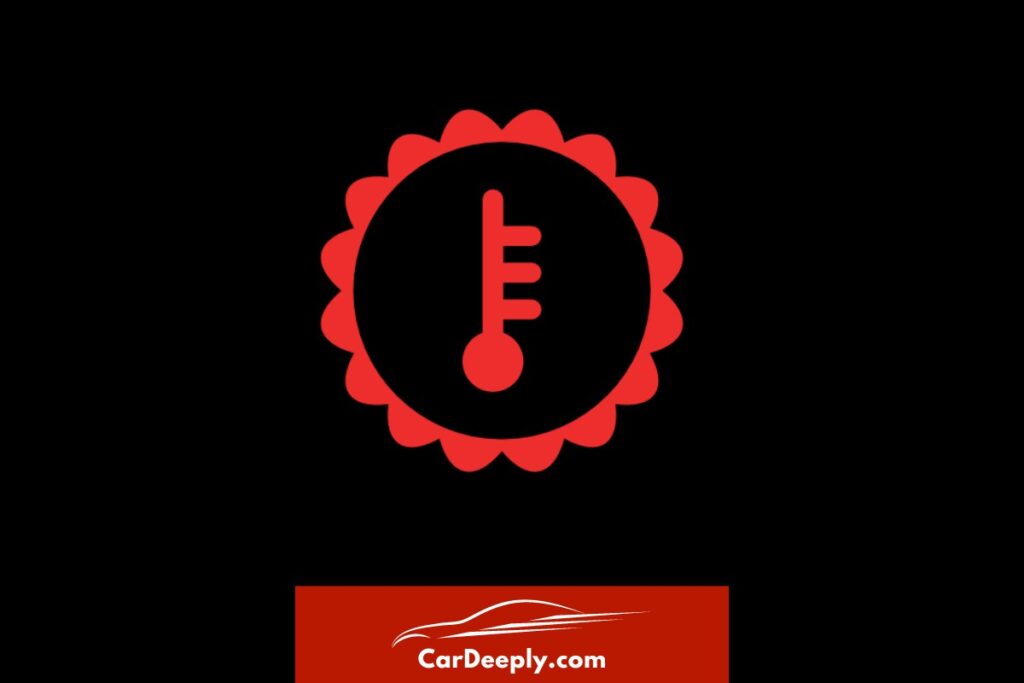When the transmission temperature warning light appears on your dashboard, your first thought will be, “Oh my God” – right?
You definitely shouldn’t neglect or take this warning light lightly.
But: it also doesn’t mean your beloved car is about to be totaled.
In this article, we’ll tell you how to deal with a transmission temperature warning light correctly:
- What does the warning light mean?
- Why does the transmission temperature warning light appear?
- What is the correct procedure?
Curious?
Let’s go!
Advertising links are marked with *. We receive a small commission on sales, nothing changes for you.
Key Takeaways
- The Transmission Temperature Warning Light alerts to potential transmission issues.
- Common triggers include overheating, low fluid levels, and internal failure.
- Immediate action is crucial when the warning light illuminates.
- Regular maintenance helps prevent transmission problems.
- Safe driving habits can avoid overheating transmission.
Understanding the Transmission Temperature Warning Light

The Transmission Temperature Warning Light is crucial to your vehicle’s dashboard.
This light serves as an early warning system, alerting you to potential vehicle transmission issues. It is typically represented by a gear symbol with an exclamation mark or a thermometer inside.
However, the exact sign can vary depending on the make and model of your vehicle.
Understanding this warning light is essential for maintaining the health and longevity of your vehicle’s transmission, one of your car’s most critical and expensive parts.
Reasons for the Transmission Temperature Warning Light
Let’s take a look on some reasons:
Transmission Overheating
One of the most common reasons for the Transmission Temperature Warning Light to illuminate is Transmission Overheating.
This situation can occur for various reasons, such as an obstructed transmission cooler or internal transmission problems. Certain driving habits, like towing a heavy load, can also lead to transmission overheating.
When the transmission overheats, it can lead to:
- Reduced transmission lifespan
- Increased risk of transmission failure
- Potential damage to other vehicle components
Low Transmission Fluid Level
A Low Transmission Fluid Level is another common cause for the Transmission Temperature Warning Light.
The transmission fluid is vital for smooth transmission operation, and a low fluid level can lead to performance issues and potential internal damage. It’s important to remember that, unlike engine oil, transmission fluid doesn’t burn up under normal circumstances.
Therefore, if the fluid level is low, it indicates a leak that needs to be addressed.
Internal Transmission Failure
Internal Transmission Failure is a serious issue that can trigger the Transmission Temperature Warning Light.
Automatic transmissions are complex systems with numerous internal components like clutch packs and planetary gear sets. If one or more of these components fail, it can lead to abnormal vehicle operation and trigger the warning light.
Shift Interlock Issues
The Transmission Temperature Warning Light doesn’t always indicate a problem with the transmission itself.
However, in some vehicles, like certain BMW models, the light may illuminate when there’s an issue with the Shift Interlock System. This system prevents the driver from shifting out of the “park” without the brake pedal being depressed.
Therefore, any malfunction in this system can trigger the warning light.
Valve Body Problems
Traditional automatic and continuously variable transmissions (CVTs) have a valve body.
The valve body directs fluid flow through valves to various transmission parts.
Modern valve bodies often contain the transmission control module (TCM) and other electronics. Any issue with the valve body can prevent the transmission from operating as it should, triggering the Transmission Warning Light.
By understanding these potential causes for the Transmission Temperature Warning Light, you can take proactive steps to maintain your vehicle’s transmission and ensure a smooth and safe driving experience.
What to Do When the Transmission Temperature Warning Light Comes On
When the Transmission Temperature Warning Light illuminates, it’s crucial to take immediate action.
Ignoring this warning could damage your vehicle’s transmission, resulting in costly repairs or a complete transmission replacement.
Immediate Actions to Take
If the Transmission Temperature Warning Light comes on while you’re driving, follow these steps:
- Safely pull over.
- Turn off the engine.
- Allow the transmission to cool down.
Remember, the Transmission Temperature Warning Light is there to alert you of potential issues. Therefore, taking it seriously and promptly preventing further damage is essential.
Checking the Transmission Fluid Level
Regularly checking your vehicle’s transmission fluid level is a good practice. It can help you identify potential issues before they become serious problems.
Here’s how to check your transmission fluid level:
- Park your vehicle on a level surface.
- Start the engine and let it warm up.
- Locate the transmission fluid dipstick.
- Pull out the dipstick and wipe it clean.
- Reinsert the dipstick and pull it out again.
- Check the fluid level on the dipstick.
If the fluid level is low, it indicates a leak that needs to be addressed. If the fluid is dark, it’s almost certain that your transmission is overheating.
Importance of Professional Inspection
While these steps can help you identify potential issues, a professional must inspect your vehicle if the Transmission Temperature Warning Light comes on.
A professional mechanic or transmission specialist can accurately diagnose the problem and recommend the necessary repairs or maintenance.
Preventive Measures to Avoid Transmission Overheating
Prevention is always better than cure. So here are some preventive measures to avoid transmission overheating and ensure a smooth and safe driving experience.
Regular Maintenance and Checks
Regular maintenance is crucial for the longevity of your vehicle’s transmission. This includes frequent oil changes, transmission fluid checks, and routine inspections.
In addition, regular maintenance can help identify potential issues early and prevent costly repairs.
Safe Driving Habits
Your driving habits can significantly impact the health of your vehicle’s transmission.
Here are some safe driving habits that can help prevent transmission overheating:
- Avoid towing heavy loads.
- Don’t ride the brakes.
- Avoid rapid acceleration.
- Don’t shift gears while moving.
By following these preventive measures and maintaining safe driving habits, you can ensure the longevity of your vehicle’s transmission and enjoy a smooth and secure driving experience.
Frequently Asked Questions
How often should I check my transmission fluid level to prevent the Transmission Temperature Warning Light from coming on?
It’s recommended to check your transmission fluid level every month. Regular checks can help you identify leaks or low fluid levels before they lead to more serious problems, such as overheating transmission.
Can I still drive my car if the Transmission Temperature Warning Light comes on, but the car seems to be running fine?
Even if your car appears to be running fine, it’s not advisable to continue driving when the Transmission Temperature Warning Light is on.
This light indicates potential issues with your transmission, and ignoring it could lead to severe damage and costly repairs.
What type of driving habits can lead to transmission overheating?
Certain driving habits can contribute to transmission overheating. These include towing heavy loads, rapid acceleration, riding the brakes, and shifting gears while the vehicle is moving.
Adopting safe driving habits can help prevent transmission overheating and prolong the lifespan of your transmission.
How often should I have my vehicle’s transmission professionally inspected?
Having your vehicle’s transmission professionally inspected at least once a year is recommended.
Regular professional inspections can help identify potential issues early and ensure the longevity of your transmission.
Can regular maintenance prevent the Transmission Temperature Warning Light from coming on?
Yes, regular maintenance is crucial for your vehicle’s transmission health. This includes frequent oil changes, transmission fluid checks, and routine inspections.
In addition, regular maintenance can help prevent the Transmission Temperature Warning Light from coming on by identifying potential issues early.
Conclusion
The Transmission Temperature Warning Light is a crucial component of your vehicle.
It alerts you to potential vehicle transmission issues, allowing you to take immediate action and prevent further damage.
By understanding the reasons for the warning light and knowing what to do when it comes on, you can ensure the longevity of your vehicle’s transmission and enjoy a smooth and safe driving experience.

Sebastian loves convertibles and drove a BMW 335i for a long time (325 hp is just a dream). Today, with two children, he is more concerned with SUVs and family-friendly vehicles. In addition to an Audi A4 Avant, he also drives a Cupra Formentor VZ – even as a family man, you can’t do without speed. Get to know Sebastian better and visit the About Us page.
Advertising links are marked with *. We receive a small commission on sales, nothing changes for you.
